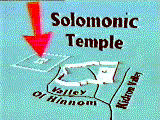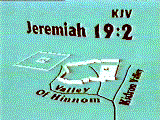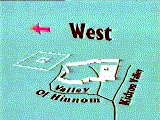The Hidden City
The PreBabylonian Jerusalem
(File 1 Of 6)
The Facts: Dutch archaeologist Margreet Steiner (July/August 1998, BAR Magazine, Volume 24, No. 4) claimed "It's Not There." Yes, evidence and the lack of findings declare that ancient Jerusalem (the real City of David) is not where the "experts" and politicians have proclaimed it to be. Thus, Dr. Steiner rightfully claims "Archaeology Proves A Negative."
"'No remains of a town, let alone a city, have ever been found from 1000 B.C.E.: not a trace of an encircling wall, no gate, no houses. Not a single piece of architecture. Simply nothing!' writes one specialist on Jerusalem."BAR, Vol. 24, No. 4, page 3,
July/August 1998
Yes, after more than 30 years of searching for evidence of preExilic Jerusalem in the wrong place, some archaeologists are admitting "It's not there" but others blindly persist that it is.
History: The early Jerusalemites (called Jebusites, the inhabitants of Jebus) first appeared on the scene shortly after The Flood, i.e. shortly after Noah and his followers arrived in Kirjath Arba (Hebron) from Teman (c. 1656 from Creation, i.e. c. 2350 BC) (Habakkuk 3:3). Subsequently, Jebus should have evolved into a rather extensive city complete with walls, gates, houses, water/sewer system, etc. [Genesis 10:16; 15:21; et al; also see: Jebus and Jebusite(s) in Scripture]. Jebus refers to a threshing floor, one who tramples. And Jebus, a Canaanite City, is the aboriginal name of Jerusalem (Genesis 10:15-19).
Therefore, early Jerusalem originated as a Canaanite settlement as the early Jebusites migrated 20 miles up the countryside from Hebron perhaps between 2350 BC and 2000 BC to found the city of Jebus that later became Jerusalem (not the traditional "Old City"). Thus, this ancient city existed for more than 1,500 years until King Nebuchadnezzar came and took its inhabitants captive to Babylon beginning in 3502 from Creation (i.e. 504 BC).
So, again, there should be ample signs of ancient gates, walls, houses, etc. Yes, Scripture cites that Jebus even had a castle, a fortress, eventually called The City of David ... contrary to what some pseudo archaeologists would like people to believe (See the pedantic diatribes against Dr. Steiner by Jane Cahill and Nadav Na'aman published in BAR Magazine, Vol. 24, No. 4). That is, because they and their cohorts look in the wrong places, they obviously did not find traces of any associated walls, gates, housing, castle, etc. Therefore, they conclude that such remnants never existed. But they persist in falsely proclaiming the phony traditional site to be the ancient City of David. Hummm! It might help to look in the right places and consider Measuring The City. (Also see: Four Rows Of Three).
Falsehoods Will Be Exposed: Indeed the traditional City of David is an obvious phony, a hoax, just like the phony temple mount, just like the phony claims by the Jewish State to the name and title "Israel," just like the phony Mount Sinai, just like the phony Noah's Ark site in Eastern Turkey, etc.
However, when people wake up: (1) There are two real Cities of David: One is West of the Hinnom where David dwelt in the castle or fortress (II Samuel 5:9; I Chronicles 11:5,7); The other is Hebron where David had been anointed King. That's where the tombs of the Kings reside atop Kob al Janib North Northwest of the modern quarry (II Chronicles 24:25; II Kings 12:21). (2) There are three separate Temple sites whose preserved remains await reentry; (3) There was a fourth Temple (Hadrian's pagan temple dismantled by Helena) which had been built beneath the phony traditional mount ... even the Roman East Gate, now well buried beneath the traditional East Gate, may be seen on The Madaba Map. The existence of that Roman East Gate was confirmed by James Fleming in 1971 and Fleming's confirmation was then kept secret for about 14 years; (4) There will be a true Israel identified before the Final 42 Year-Hour ends; (5) There is a true Mount Sinai situated about 200 miles North of the phony traditional site; (6) The remains of Noah's Ark will be unearthed North of Tayma', Saudi Arabia; and, (7) There are two Holy Arks being held captive by the occupation forces since 1985 (Zechariah 5:4). Smile!
Back To The Temples: Yes, the "experts" have been looking in the wrong places including Nehemiah who returned from the Babylonian captivity only to search in "darkness" (i.e. without knowledge nor understanding) and he didn't tell anyone he couldn't find it. As a result, a second Temple was built atop David's Tomb situated beneath what is now called the Western Hill. (Note: This site should not be confused with the phony tomb of David identified for tourists at the Southern tip of the Western Hill).
Thus, Nehemiah is the culprit, the fall guy, responsible for the relocation of the ancient City of Jerusalem upon Jewry's return from their Babylonian Exile.
Today, in the region of the Wailing Wall, one can see the West wall enclosing the phony traditional mount. A portion of the foundation of that wall should prove to be associated with Nehemiah's structures surrounding the Second Temple. That is, each Temple was erected within one quadrant of an amphitheatre called "The City" which was centered within the literal Levitical City.
Note: The Rabbis, following the Babylonian Exile, changed the basic wall construction criteria. That is, the Talmud establishes that instead of the walls being four-square, a wall may be pushed out here if it is pulled in there. Thus, unlike the four-square walls associated with the Solomonic Temple and the surrounding original Levitical City of the earlier era, the walls for Nehemiah's and, later, Herod's structures did not closely follow the basic four-square design criteria given Solomon. And neither of GOD'S two Holy Arks were ever placed within either of the second and third Temples.
O.K., the third Temple, Herod's Temple, was built under the authority of Herod The Great. Its preserved remains now reside under the modern Muslim Quarter (the mound just East of the Damascus Gate). Great pillars once part of the amphitheatre enclosing Herod's Temple are now part of a modern convent and are called the Fortress of Antonia. Remember, Jesus' last supper, His trial, crucifixion, death, burial, and resurrection ... all occurred within the great amphitheatre enclosing Herod's Temple.
Also, from within the preserved ruins of Herod's Temple, Bar Kochba and his followers came out by night and attacked Roman Emperor Hadrian (c. 134 AD). Earlier, while Hadrian was visiting Apollonius in Egypt, Bar Kochba had excavated the area now occupied by the phony traditional mount and heaped the earth atop the ruins of Herod's Temple, rebuilt walls, built housing atop the mound covering the Temple ruins, etc. All was done to conceal the Herodian Temple site from Hadrian. Apparently Jewish agents even murdered Apollonius to further delay Hadrian's return from Egypt. However, when Hadrian eventually returned, Hadrian was then told that the excavated area was the Temple site. Thus, Bar Kochba's ruse worked and Hadrian built his pagan temple on the phony site.
The problem that subsequently evolved is that Bar Kochba's ruse has persisted through the millennia even unto today. People have fought and killed one another over that phony site. And, even today, myriad people bow to and pray to the remnants of Hadrian's pagan temple while standing with their backs to the Solomonic Temple (Psalm 5:7; Jeremiah 19:2; Ezekiel 8:16-18).
The Solomonic Temple, The First Temple: Nevertheless, the Scriptures identify the location of the East Gate of the Solomonic Temple as being West of the Valley of Ben Hinnom (Jeremiah 19:2 KJV; Joshua 15:7-8). So, if the East Gate opens out into the Hinnom then the ancient Levitical City and Temple of Solomon must be West of the Hinnom. It's common sense.
  
 |
Next, consider the identity "... of the mountain that lieth before the valley of Hinnom westward..." (Joshua 15:7-8). Remember, the Solomonic Temple did not exist in Joshua's day and there's no physical mountain of consequence West of the Hinnom or was there! Yes, when in Babylon even Daniel referred to early Jerusalem, the preExilic City, as "thy holy mountain" (Daniel 9:16; Isaiah 66:20; Jeremiah 31:23; Zechariah 8:3). And Joshua 15:7-8 said that up to then Jerusalem had been West of the Hinnom.
The Temple Destruction: Preparations for the Solomonic Temple destruction actually had begun when King Sennacherib came against Jerusalem, the early or preExilic Jerusalem, in 3397 from Creation (609-608 BC) in the 14th year of King Hezekiah.
Note: The Assyrian King Sennacherib certainly would not have set up his siege headquarters near Lachish (i.e. near the Lakhish River or Brook) if the City of Jerusalem were not West of the Hinnom (II Kings 18:13,17; 20:20; II Chronicles 32:3-4,9,30; Isaiah 36:1-2). That is, Hezekiah had stopped up the nearby water sources including the Sorek River in the middle, the Ajalon to the North, and the Elah to the South of the Sorek. All were far closer to early Jerusalem, Sennacherib's main objective, rather than the Lakhish River which was much farther to the South.
We'll get back to these water sources in a moment, but first consider preparations for the Solomonic Temple's destruction.
During Sennacherib's siege of the preExilic City, Sennacherib apparently mounded earth atop portions of the city, city walls, and about the Temple area using captive slave labor.
The Prism of Sennacherib, possessed by the Oriental Institute, was found in the ruins of Sennacherib's Palace at Nineveh and relates Sennacherib's version of his siege of preExilic Jerusalem. Therein, Sennacherib boasts of conquering by means of well stamped earth ramps, etc. And Sennacherib declared that Hezekiah had been made prisoner in Jerusalem much like a bird in a cage surrounded by earthworks.
"As to Hezekiah, the Jew, he did not submit to my (Sennacherib's) yoke, I laid siege to 46 of his strong cities ... and conquered (them) by means of well-stamped (earth-) ramps and battering-rams ... Himself I made a prisoner in Jerusalem (preExilic Jerusalem), his royal residence, like a bird in a cage. I surrounded him with earthwork...."Prism of Sennacherib
Oriental Institute
For Another Translation See:
http://www.stolaf.edu/people/kchanson/sennprism3.html
Subsequently, the Persians and then Nebuchadnezzar made an end to habitations within preExilic Jerusalem. During King Nebuchadnezzar's 23 year siege he apparently completed covering the City with earth. And, when Zedekiah collapsed the Temple side chambers and towers atop the inner Temple, Nebuchadnezzar covered that too. Today, other structures are built atop the Solomonic Temple site and the early Castle of David. Other structures were also destroyed and covered during the annals of history. Today, one can reenter abandoned, partially excavated, ruins of these later structures as they, complete with their windows, are encased in a lime-like earth much of which has turned to a limestone rock over the centuries.
Meanwhile, the ruins of the preExilic Jerusalem and the Solomonic Temple's preserved remains remain nestled in their earthen tomb not far below. In the mid 1980's an unkept Independence Garden Park and a battered Moslem cemetery, whose engraved stones have been almost wholly looted, now mark the spot atop the once majestic Solomonic Temple and Levitical City.
Speaking Of The Phony Gihon And The Falsely Identified Siloam Tunnel Purportedly Built By Hezekiah: John Rogerson and Philip R. Davies, Professors at the University of Sheffield in England wrote a joint paper published in the September 1996 issue (#59) of Biblical Archaeologist magazine published by the American Schools of Oriental Research. The Rogerson-Davies paper is titled: "Was The Siloam Tunnel Built By Hezekiah?" Therein, the authors questioned the validity of certain archaeological practices and proposed that the "use of the Siloam Inscription for dating other inscriptions should be abandoned." Rogerson and Davies strongly suggested that the Siloam Inscription (taken from the falsely identified tunnel) should be more properly dated in the second century BC. This created quite a stir amongst many pseudo experts as the Siloam Inscription has been a cornerstone of Hebrew paleography for six century script.
Common sense and the Scriptures point out that Rogerson and Davies may very well be correct.
Next consider that when Sennacherib came against the preExilic Jerusalem and the 46 cities in the days of Hezekiah (i.e. 609-608 BC), how much notice did Hezekiah have to dig extensive tunnels through rock? His prime concern was to shut off, divert, and conceal water sources. How much of a tunnel could be dug in a short time with crude tools of that day? When examining the traditional falsely identified tunnel erroneously attributed to Hezekiah, only a few people could work at a time in the narrow spaces; so, without modern jack hammers and other modern tunneling tools (which Hezekiah didn't have), that tunnel (1730 feet/1200 cubits through rock) took a considerable effort and time. And that particular tunnel obviously wasn't excavated with Sennacherib knocking on the city gates.

The Temple Water Supply:
About 1,200 years after the Canaanite City of Jebus was founded, Solomon began building his Temple in his fourth year (i.e. 3098 from Creation /908 BC). Then 300 years later King Sennacherib came against the City of Jerusalem in the 14th year of King Hezekiah (II Kings 18:13; Isaiah 36:1).
Again, the City of Jebus required water and when Solomon built his Temple, the Solomonic Temple required lots of water too! So, where did it come from? Obviously not from the traditional (false) Gihon and not from the traditional (false) Hezekiah's Tunnel to the South of the traditional (false) temple mount and phony City of David.
Common sense says, the Jebusites, followed by King Saul, King David, King Solomon, and the many kings which came after Solomon ... everyone obviously didn't wait for King Hezekiah (about 1,500 years after the founding of Jebus) to bring water into the city. Furthermore, when the Solomonic Temple was built, there were great cisterns (reservoirs) including a complete water-sewer system under the Temple.
So, in reality, King Hezekiah simply blocked the excess waters from flowing into the Elah, the Sorek, and the Ajalon Rivers and allowed the needed waters to continue flowing into the existing tunnels that brought fresh waters into the city, the castle, and the Temple [II Kings 20:20; II Chronicles 32:3-4,30; Ben Sira (Ecclesiasticus) 48:17]. That's why King Sennacherib set up his siege headquarters near the Lakhish ... he needed water for his army when Hezekiah stopped up the adjacent water sources.
The 185,000 Sudden Deaths: (II Kings 19:35; Isaiah 37:36): Consider what happened when the available fresh water supply had been shut off from Sennacherib's forces outside the preExilic City while waters continued flowing into the City. Yes, as a result the sewer waters had to continue flowing out beyond the City walls. Meanwhile, Sennacherib's army and myriad captives from the 46 cities were busily building earthramps. An abundance of water was needed. So, did Sennacherib's waterbearers eventually fill their containers from the two or more sewer outflows? There was one East of the City and another on the West side. How convenient!
The sewer waters gushing forth appeared as natural springs, two Gihon's, but obviously both were quite deadly for Sennacherib's forces. And the more they retched the more water they wanted. Remember, the water bearers were undoubtedly conscripts from the 46 captured cities; so, those "fresh water" springs saved a lot of walking.
Look In The Right Place: Nearly 2,500 years ago, in 3519 from Creation, King Zedekiah slipped beneath King Nebuchadnezzar's great army in his short-lived escape. However, Zedekiah's efforts soon came to naught when Nebuchadnezzar's forces caught him in the plains of Jericho. At that time, despite threats and torture, Zedekiah did not reveal the obvious exit/reentry route into the Temple and Nebuchadnezzar never figured it out. Neither could the myriad researchers over the past 2,500 years. They still ask:
"Why indeed have the Iron Age levels of Israel produced nothing reflecting the 'Golden Age' of King Solomon?"
| Centuries Of Darkness Rutgers University Press (1993) Page 5 Peter James in collaboration with I.J. Thorpe, Nikos Kokkinos, Robert Morkot, John Frankish. |
However, by the time you finish reading through "Reentering Temple History - B" you can close your eyes and visualize reentering the majestic Solomonic Temple and the nearby Castle of David. You'll even know where the tons of Temple Treasures and the vast stash of Temple records lay hidden. The key is looking in the right places!
Select The Hidden City File:
Or |
| Prepared By Father - Son Team George & Dana Brown P.O. Box 320932 Cocoa Beach, Florida USA 32932-0932 Email: brianshouse@yahoo.com
|